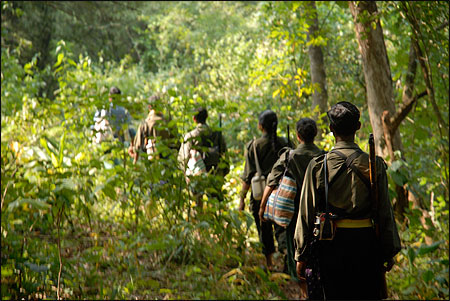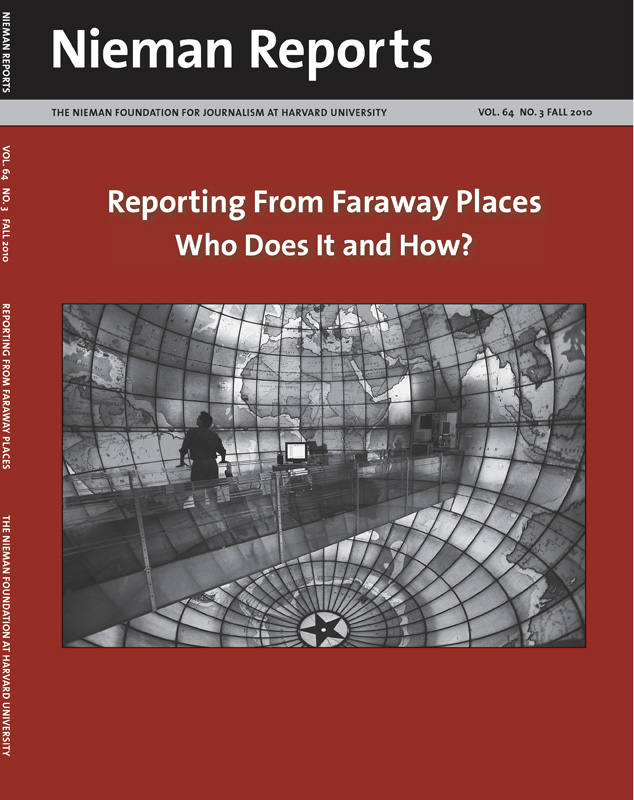
The Pulitzer Center on Crisis Reporting funded reporting on what was then a little-known Maoist insurgency in backcountry India. Photo by Jason Motlagh.
The Chinook helicopter banked hard and dropped to the ground, whipping up a cloud of dust and debris. The summer fighting season in southern Afghanistan was winding down yet bands of Taliban were still harassing villagers in the badlands of Paktika province where I was embedded with the U.S. Army, and they were now flushing them out by air assault. Local sources had relayed word earlier in the morning that militants were moving around the area. We were told to be ready for incoming fire.
It was late 2008 and I was on a video assignment for Time.com, my first. The plan was to exit the chopper and film the soldiers surging out behind me, rifles at the ready. But I also hoped to snap a few pictures to go with the print stories I had lined up for other longtime clients. “Go, go, go,” yelled the sergeant as we touched down. With my video camera rolling in one hand, my still camera slung over my shoulder, I ran out the back and quickly dove for cover in a furrow. There was no shooting but the scene on camera was lively enough: guns, grit and a thumping rotor. Or so I thought. In my haste, alternating between cameras, I later realized that I’d forgotten to switch the video camera’s external microphone back on. Most of the footage was unusable.
This wasn’t the first or last time that’s happened. As a multitasking, multimedia journalist, I find that such snafus are an inevitable part of the daily hustle, a kind of occupational tax. Juggling gear and making split-second decisions under pressure—as to what to document and how—are near-constant challenges. While it can be invigorating to do on my own what once required a crew of people, at times it can feel self-defeating. At those moments I envy colleagues who doggedly devote themselves to a single medium. Their videos or photographs often seem sharper, and their text stories are richer with nuance. Perhaps they really are.
But after working at this hectic pace—and serving these various masters of video, stills and words—for several years now, I’ve come to thrive on the mix. There’s a greater sense of freedom and storytelling possibility as the tools of the trade become more user-friendly. Most importantly, the ability to do more with less keeps me busy in an increasingly tight foreign news market.
A Pathway to Multimedia Reporting
When I was in college, journalism programs weren’t teaching multimedia skills, and I never did go to journalism school. When I first struck off for West Africa as a freelancer in mid-2005, it was to be a print correspondent. For the better part of a year I roved around the region, reporting on trans-Saharan smuggling in Mali, the civil war in Ivory Coast, and a food crisis in Niger. Along the way editors started taking an interest in my photographs. This opened my eyes to a secondary source of income that gave me a competitive edge in getting stories placed. Although a staff job at a newswire brought me back to the United States, after months of itching to be back out in the field I called it quits and decided to freelance overseas full time.
RELATED ARTICLE
“The Sometimes Bumpy Nonprofit Ride Into Digital Foreign Correspondence”
– Jon SawyerDuring a lull, I saw an ad for the Pulitzer Center on Crisis Reporting, a nonprofit organization committed to drawing attention to under-reported global issues. Their mission instantly struck a chord, and I knew partnering with them was something I needed to try to do, especially since I was relaunching with paltry resources at my disposal. Two times I applied for grants, and twice I was rejected. With stubbornness a prerequisite for this line of work, my third proposal—to report on a then little-known Maoist insurgency in backcountry India—was accepted.
I doubled down and moved to New Delhi to cover South Asia. The timing was critical. Soon after I got my first grant, a host of outlets I’d written for—the San Francisco Chronicle, The Washington Times, U.S. News and World Report—either drastically cut or stopped taking freelance foreign copy altogether, emblematic of industrywide troubles. The writing was on the wall: Shrinking news pages alone no longer offered enough space to make a living. Much to my benefit, part of the Pulitzer Center’s approach is that stories be distributed as widely as possible, across a variety of media platforms. My multimedia skills were still raw but the Pulitzer center was willing to midwife some projects, pairing me with seasoned videographers so I could learn on the job. Within months I produced my first segment for TV broadcast, tried my hand at shooting and editing my own pieces, and put together narrated slideshows.
Suddenly, it seemed, I was doing a little bit of everything, and there were incentives to keep it that way.
This Pulitzer Center partnership turned out to be the start of a productive ad hoc partnership that kick-started my career as an independent journalist. Over the past three years, the center has generously funded projects of mine in Asia, from stories about ethnic strife in Sri Lanka to ongoing work on the impact of civilian casualties in Afghanistan. To get more mileage out of the reporting they support, they have an outreach program called Global Gateway that sponsors journalists to speak at high schools and universities. At a time when many expect something for nothing, we are paid for these profile-boosting appearances, which also give us the rare chance to engage with young news consumers. They’ve also made some key introductions that have led to steady work that’s not always related to the projects they support. It’s a lot like having an agent that pays you to do what you love.
This is how I met Craig Duff, the multimedia director at Time.com. He was building his shop there and, fortunately, was willing to stomach some of my early shortcomings as a videographer. One thing I remember him saying upfront was that submissions he received tended to have the “V but not the J,” in other words, the technical video skills but not the journalistic backbone. I’m grateful for his patience. The air assault piece that I almost botched was the first of many Web videos that have allowed me to explore offbeat story topics while developing a visual style all my own. What’s more, the video entree at Time.com subsequently opened a backdoor to the editorial department.
These days my Web videos are often packaged with text stories that have become a large part of my livelihood. When news is breaking I might be writing every day. When it’s slow, I can dig into my video features. Either way, the need to change gears without breaking stride ensures the work is interesting and filled with purpose.
Being versatile requires mobility. From my new base in Istanbul, it’s easy for me to travel on short notice anywhere between Khartoum and Kathmandu. Recently I returned from a monthlong Time assignment to Afghanistan’s southern battlefront where the Taliban is ramping up the fight against American forces. The country is similarly hard on equipment; and this time out my video camera and laptop went bust in quick succession so I stuck to writing stories to salvage the trip. I also report for other outlets including The Economist and the Virginia Quarterly Review, where I have the luxury of writing longer and in my own voice. Recently I’ve teamed up with filmmaker Rick Rowley to co-produce several documentary features for Al-Jazeera’s English channel. A book project is also taking shape.
Nothing stays the same, though. If there’s one lesson I’ve learned it’s that you have to be flexible personally and professionally, embracing change as it comes. Last fall I became a father. It’s added an incredible new dimension to my life but there are extra financial strains on a freelance income and being away for long stretches of time is not what it once was. To find something close to a balance, I’ve had to become more efficient in the way I work. Instead of, say, trawling for stories in a conflict zone, I go in with a clear-cut plan, get what I need, and get out.
It’s early yet. But much like my transition into multimedia reporting, what began out of necessity is starting to have its own distinct rewards. I’m now able to make a decent living, support my family, and be more selective about the work I do—while spending much less time in lonely hotel rooms.
Jason Motlagh is a freelance multimedia journalist based in Istanbul.


